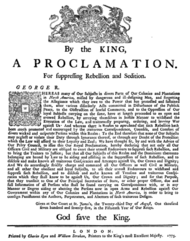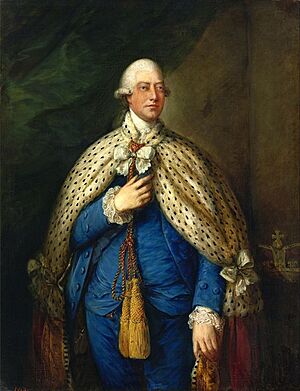Proclamation of Rebellion facts for kids
Quick facts for kids Proclamation of Rebellion |
|
 |
|
| Signers | George III of Great Britain |
The Proclamation of Rebellion, officially called A Proclamation for Suppressing Rebellion and Sedition, was a special announcement from King George III. It was his way of reacting to the news about the Battle of Bunker Hill at the start of the American Revolution.
Released on August 23, 1775, it said that parts of the American colonies were in "open rebellion." It told officials across the British Empire to do their best to stop this rebellion. The Proclamation also asked people in Britain and other parts of the empire to report anyone who was secretly helping the rebels. These people would then be punished.
How the Proclamation Was Used
The Proclamation of Rebellion was written before King George III's secretary, Lord Dartmouth, even saw a letter from the American colonists called the Olive Branch Petition. King George III refused to accept this letter from the colonists. So, the Proclamation of Rebellion on August 23, 1775, became his answer to it.
On October 27, the King's group of advisors, called North's Cabinet, added more to the proclamation. King George III read this new message in his Speech from the Throne when Parliament opened. The King's speech said that the rebellion was started by a "desperate conspiracy" of leaders. He believed these leaders only pretended to be loyal to him.
King George III said that what the rebels really wanted was to create their own "independent empire." The speech showed that the King planned to use armed force to deal with the problem. He was even thinking about getting "friendly offers of foreign assistance" to stop the rebellion. This would avoid having Britons fight against Britons. Some members of Parliament who supported the Americans warned that the government was pushing the colonists towards independence. Many colonial leaders had said they did not want this.
Ending the Proclamation
King George III spoke to Parliament on December 5, 1782. This was his first speech since Lord North had resigned as his wartime Prime Minister. Lord North's resignation happened after Parliament decided to end the war in North America.
In the time between, the King told his Lords and Gentlemen that he had quickly ordered an end to "the further prosecution of offensive war upon the continent of North America."
King George III had thought about giving up the British crown. He considered moving to his German estates as Prince of Brunswick in the Holy Roman Empire. But he then told Parliament that he would follow the wishes of "my Parliament and my people." He had promised this in his coronation speech.
King George III then reported to Parliament that he had offered the US Congress his declaration. This declaration recognized the rebelling North American colonies as "free and independent states" in the final peace treaty. He also told Parliament that this had been agreed upon, along with other early terms.
His final comment on American independence was: "Religion, language, interest, affections may, and I hope will, yet prove a bond of permanent union between the two countries. To this end, neither attention nor disposition shall be wanting on my part."


